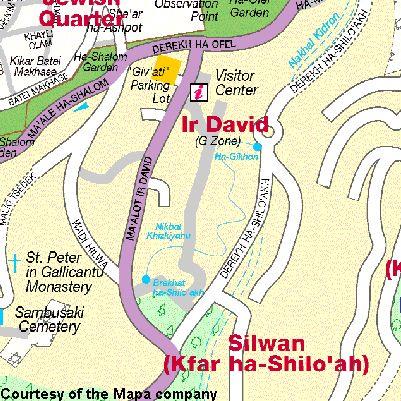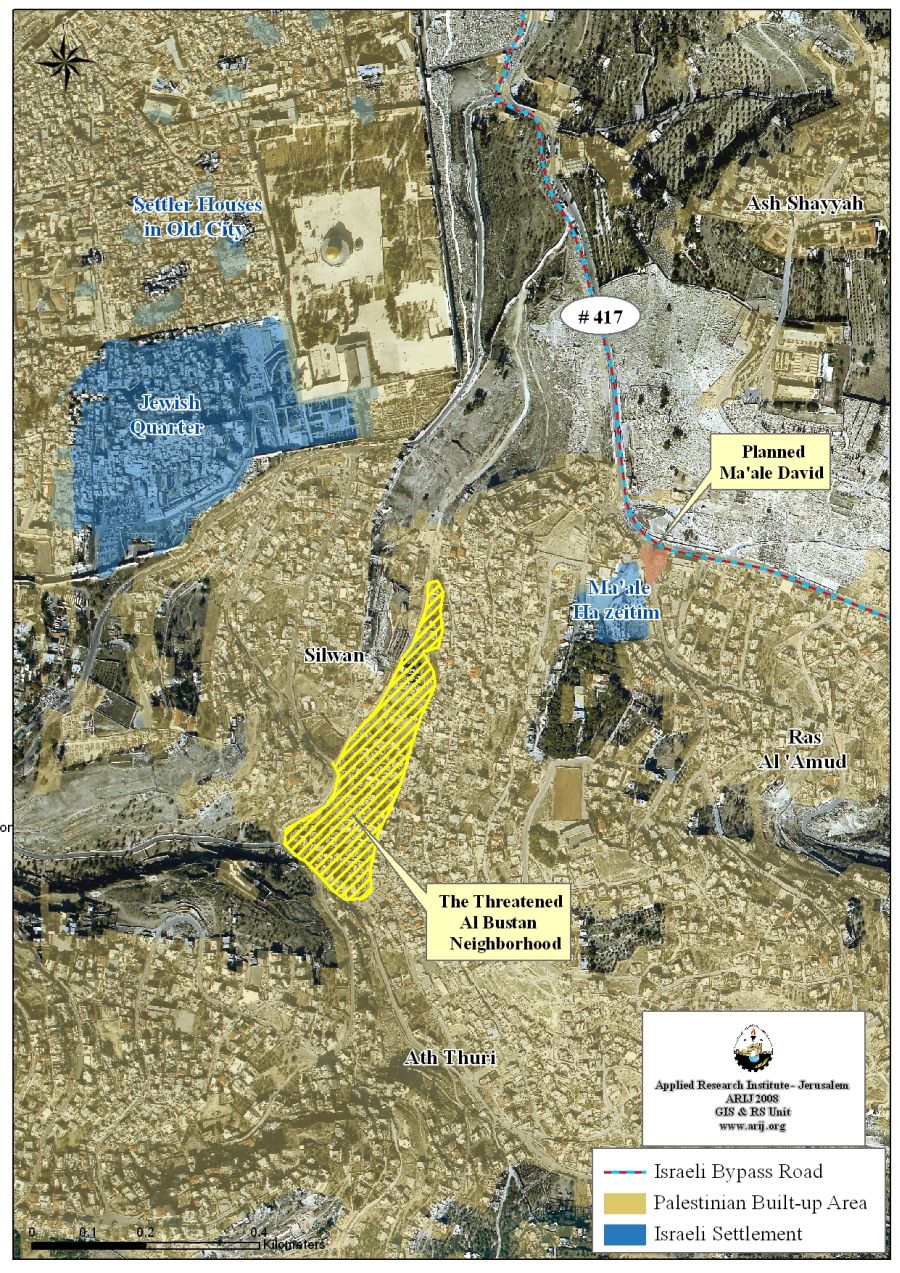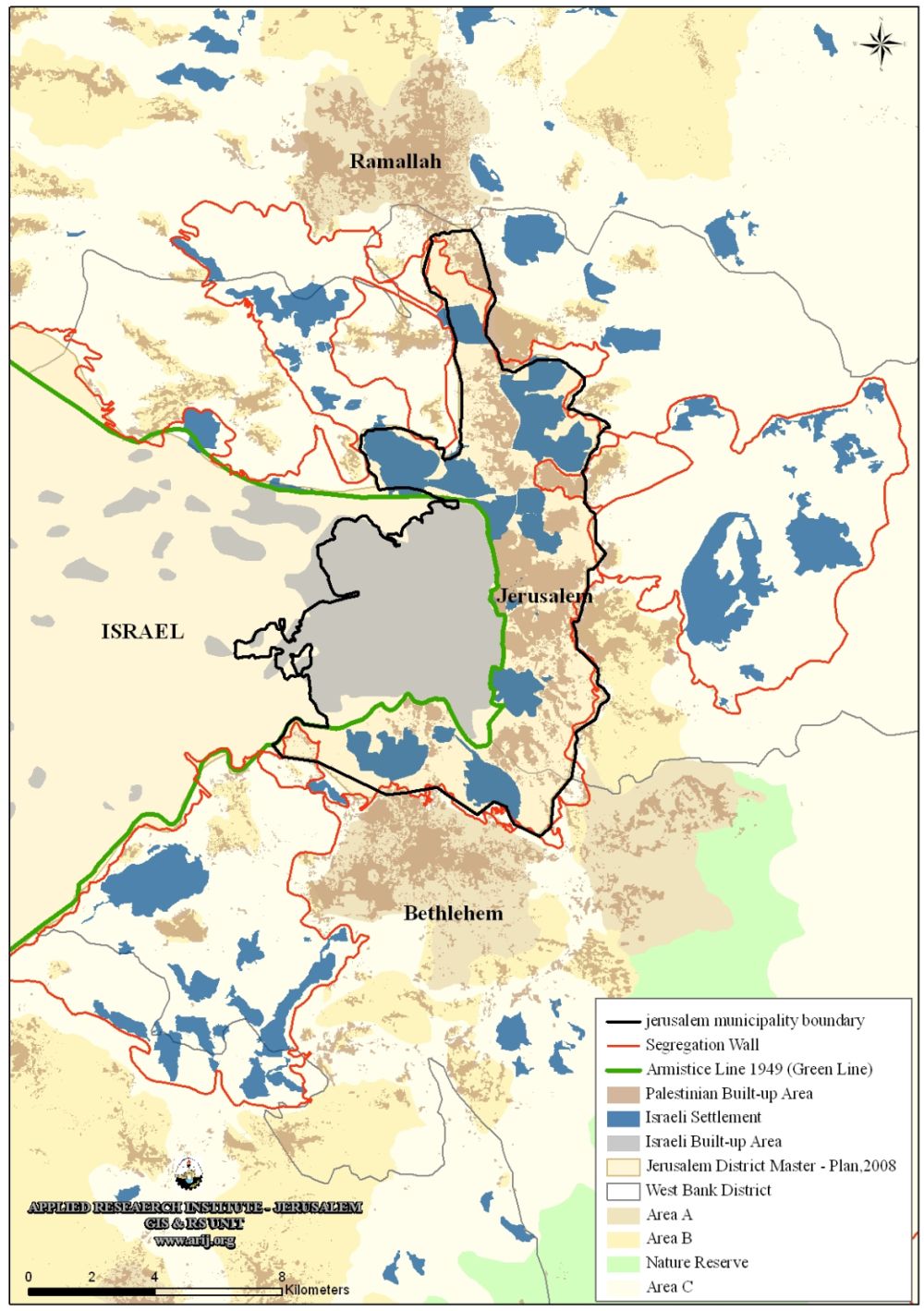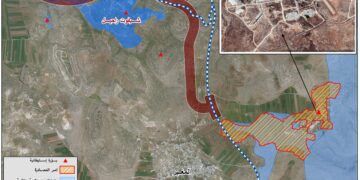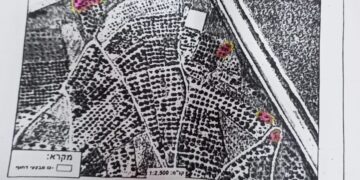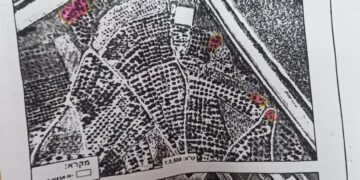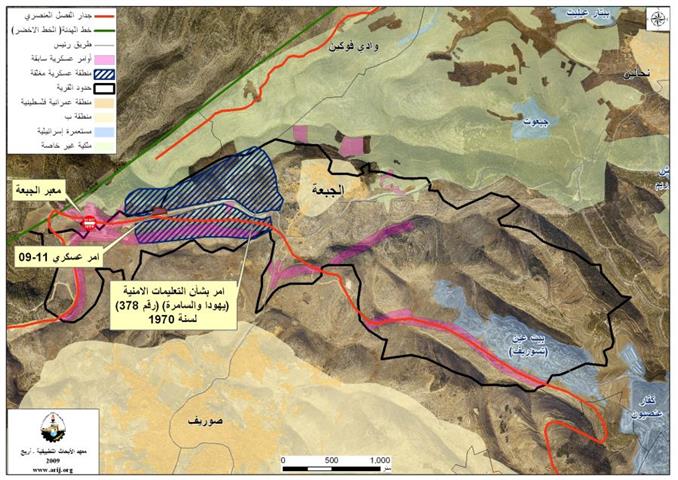On February 22, 2009, the Israeli Occupation Authorities of the Jerusalem Municipality served citizens of Al Bustan neighborhood notices to evacuate their houses voluntarily within 72 hours or else the authorities will evacuate them under the pretext of building without proper licensing documents. The process came after the Municipality announced on February 20, 2009 about a plan to relocate the 1,500+ Palestinian citizens living in the 88 houses of Al Bustan neighborhood in Silwan neighborhood to alternative locations, one on a different hill in Silwan city north of Jerusalem city, and the other in Beit Hanina town north of Jerusalem.
Earlier on July 1, 2008 The Jerusalem Municipality announced its willingness to revive plan number (E/M/9), a plan which was designed by the Jerusalem Municipality Engineer during the 1970's and called for the demolition of 88 Palestinian houses in Al Bustan neighborhood in Silwan city south of Jerusalem city on 50 dunums of land.
Ethnic cleansing in Silwan City
Silwan City is located to the southeastern part of Jerusalem's old city. The town extends along the Qedron Valley and runs alongside the eastern slopes of Jabal Al-Mukabbir. Since the occupation of the West Bank including East Jerusalem and the Gaza Strip East Jerusalem in 1967, the town has been targeted by the Israeli government as well as by Jewish organizations such as 'Ateret Cohanim and El 'AD Jewish organizations. El 'AD foundation was established in 1986 with the aim of constructing what is called the 'city of David' (Ir David in Hebrew) in the place that is home to the Silwan citizens for hundreds of years.
The colonization attach on Silwan escalated since 1991, were since then more than 40 houses were taken over by force by Jewish settlers. On the maps issued by the Israeli Jerusalem Municipality and Jewish organizations, part of Silwan is labeled 'City of David' (Ir David in Hebrew), so are the street signs that direct to 'Ir David' without mentioning Silwan, despite the fact that this neighborhood is mostly owned and inhabited by Palestinians. Al Bustan neighborhood in Silwan is a section of the part labeled 'Ir David' and was the most targeted one because of its proximity to the western wall of the Old City.
Source of map: http://www.jerusalem.muni.il/jer_main/f1_main.asp?lng=2
In the same time, the Israeli forces are supporting the Israeli settlers to take over by force the Palestinian houses in Silwan city. The Israeli plan is to take over this neighborhood and link it with a tunnel to the Wailing Wall plaza. At least 11 houses in Silwan city were taken by force by Israeli settlers (were 25 families are currently livingadditionally a Talmudic center and a visitor's center -that is responsible for conducting tours along the old cisterns and tunnels that lie beneath Silwan- were founded. It is also proposed to initiate commercial and tourist centers in the area. Furthermore, Israel plans to form a territorial link between the Jewish settlement inside the old city known as the Jewish quarter and the induced settlements in what is called 'the Holy Basin area,' which includes Al Sheikh Jarah, Wadi el Joz, Al Tur (Mount of Olives), Ras Al Amoud, Jabal El Mukabir and Silwan. See Map 1 additionally a Talmudic center and a visitor's center -that is responsible for conducting tours along the old cisterns and tunnels that lie beneath Silwan- were founded. It is also proposed to initiate commercial and tourist centers in the area. Furthermore, Israel plans to form a territorial link between the Jewish settlement inside the old city known as the Jewish quarter and the induced settlements in what is called 'the Holy Basin area,' which includes Al Sheikh Jarah, Wadi el Joz, Al Tur (Mount of Olives), Ras Al Amoud, Jabal El Mukabir and Silwan.additionally a Talmudic center and a visitor's center -that is responsible for conducting tours along the old cisterns and tunnels that lie beneath Silwan- were founded. It is also proposed to initiate commercial and tourist centers in the area. Furthermore, Israel plans to form a territorial link between the Jewish settlement inside the old city known as the Jewish quarter and the induced settlements in what is called 'the Holy Basin area,' which includes Al Sheikh Jarah, Wadi el Joz, Al Tur (Mount of Olives), Ras Al Amoud, Jabal El Mukabir and Silwan.
Al Bustan Neighborhood
Recently the Israeli municipality of Jerusalem has slated a whole neighborhood in Silwan called Al Bustan neighborhood for demolition. More than 88 houses in Al Bustan will be demolished, these houses are home to more than 1000 residents a large percentage of which are children. If this demolition will be carried out, it would be the largest demolition act after the demolition of Al Magharbe neighborhood inside the Old City in 1967. Nearly half of the house owners in Al Bustan received a court order demanding the demolition of their houses. The land of Al Bustan neighborhood is privately owned. Some houses were built before the occupation of Jerusalem in 1967, the rest were constructed during the 1980s and 1990s. A National park called 'the King's Valley' is planned to replace the residential neighborhood. Uri Shetrit the municipality's engineer declares that the intension is to return this part of Silwan 'to its landscape of yore,regardless of the Palestinians who are living there. See Map 2
In this case the municipality not only uses the 'building without a permit' pretext in its case against local citizens, rather according to Uri Shetrit the building without a permit offence runs out after seven years according to the Israeli law, and since many of the houses in Al Busatn slated for demolition were built more than seven years ago, Shetrit ensures that 'there's no statute of limitations on using the illegal house, so we can bar residents from entering their homes, even if we can't destroy them,' thus a house can be lined up for demolition because it is 'abandoned'.. Law 212 of the Israeli Planning and Building Law is also used to manipulate the act of demolition; the law is for the cases were demolition is carried out without conviction. The law states that:
|
'Where an offence under this Chapter [Offences and Penalties] has been committed in respect of any building and, if any person had been convicted thereof, the Court would have been competent to order as provided in section 205, the Court may so order even without any person having been convicted as aforesaid, provided one of the following applies : 1. The person who committed the offence cannot be found; 2. it is impossible or impracticable to serve a summons upon him; 3. the person who was the owner of the building at the time the offence was committed, and who committed it, is no longer the owner thereof ; 4. it cannot be proved who committed the offence: 5. the person who committed the offence has died or is not punishable for reasons which do not make the act legal.' (Israel Law Resource Center, online, emphasis added). |
This law was also used in 1967 to erase the Palestinian Al Magharbeh neighborhood inside the old city to form the plaza in front of Al Buraq Wall (known as the Wailing Wall).
Israeli planning apparatus in East Jerusalem
Since the 1967 war and the occupation of East Jerusalem, the Israeli political goal was clear and definite; increasing the Israeli population in Jerusalem and decreasing the Palestinian one; united Jerusalem the capital of Israel and having total sovereignty on land. These goals were achieved through well-studied planning strategies that imposed restrictions and regulations that prohibited expansion and development of the Palestinian communities and supported the extensive expansion of the Israeli settlements. The strategies used were: expropriation of lands; freezing the expansion of Arab areas by hardening the process of obtaining a building permit, imposing limitations on floor area ratio, by keeping some blocks unzoned , zoning 40% of the land in East Jerusalem as 'Green Area' and by constructing highways that cut the Palestinian expansion. East Jerusalem today lacks the urban constituent, is functioning as a suburb (rather than a city), marginalized, divided into separated neighborhoods, totally separated from the rest of the West Bank, surrounded by the Segregation Wall, deprived from economic development, encounters shortage in housing, lacks the essential infrastructure and suffers from environmental problems. See map 3
Map 3: Palestinian and Israeli Built-up areas in Jerusalem
House demolition in light of human rights, international covenants and treaties
Adequate housing is one of the basic needs and rights of each person, where 'the right to adequate housing is the right of every woman, man and child to a place to live in security and dignity.'In the occupied Palestinian territory, Israel as an occupier should abide by the international human rights treaties to which it is a state party including: The International Covenant on Economic, Social and Cultural Rights (ICESCR) and the International Convention on the Elimination of All Forms of Racial Discrimination,. As an occupier Israel should also abide by the international humanitarian law including: The Hague Regulations and the Forth Geneva Convention. The demolition of houses in Al Bustan neighborhood would be a stark violation of these rights and covenants. Israel should be held accountable for its acts in occupied East Jerusalem and the other Palestinian Territory; should comply with the international legitimacy, laws treaties and United Nations' resolutions; and Israel's long time apathy of the international community's wills must come to an end.
Following is a synopsis of Articles within these covenants, conventions and laws that address the issue of house demolitions and forced evictions under these articles:
International Covenant on Economic, Social and Cultural Rights
-
Article 11 (1): 'The States Parties to the present Covenant recognize the right of everyone to an adequate standard of living for himself and his family, including adequate food, clothing and housing, and to the continuous improvement of living conditions'.
International Convention on the Elimination of All Forms of Racial Discrimination (1965)
-
Article 5: 'States' Parties undertake to prohibit and eliminate racial discrimination in all of its forms and to guarantee the right of everyone, without distinction as to race, color, or national or ethnic origin, to equality before the law, notably in the enjoyment of the following rights: … (e) in particular … (iii) the right to housing'.
Universal declaration of human rights, Article 17:
1. 'Everyone has the right to own property alone as well as in association with others.'
2. 'No one shall be arbitrarily deprived of his property.'
Article 25:
1. 'Everyone has the right to a standard of living adequate for the health and well-being of himself and of his family, including food, clothing, housing and medical care and necessary social services, and the right to security in the event of unemployment, sickness, disability, widowhood, old age or other lack of livelihood in circumstances beyond his control.'
The Fourth Geneva Convention
-
Article 53: 'Any destruction by the Occupying Power of real or personal property belonging individually or collectively to private persons, or to the State, or to other public authorities, or to social or cooperative organizations, is prohibited, except where such destruction is rendered absolutely necessary by military operations.'
-
Article 47: 'Protected persons who are in occupied territory shall not be deprived, in any case or in any manner whatsoever, of the benefits of the present Convention by any change introduced as the result of the occupation of a territory, into the institutions or government of the said territory, nor by any agreement concluded between the authorities of the occupied territory and the Occupying power, nor by any annexation by the latter of the whole or part of the occupied territory.'
-
Article 147: 'Grave breaches to which the preceding Article relates shall be those involving any of the following acts … extensive destruction and appropriation of property, not justified by military necessity and carried out unlawfully and wantonly.'
Hague Regulations 1907
-
Section II Article 23: 'it is especially forbidden- to destroy or seize the enemy's property, unless such destruction or seizure be imperatively demanded by the necessities of war.'
-
Section III Article 46: 'Family honor and rights, the lives of persons, and private property, as well as religious convictions and practice must be respected. Private property cannot be confiscated.'
Agenda 21 (UNCED, 1992)
Chapter 7.6 : 'Access to safe and healthy shelter is essential to a person's physical, psychological, social and economic well-being and should be a fundamental part of national and international action. The right to adequate housing as a basic human right is enshrined in the Universal Declaration of Human Rights and the International Covenant on Economic, Social and Cultural Rights. Despite this, it is estimated that at the present time, at least one billion people do not have access to safe and healthy shelter and that if appropriate action is not taken, this number will increase dramatically by the end of the century and beyond.'
'People should be protected by law against unfair eviction from their homes or land'.
:::::::::::::_
[1] ELAD foundation website, http://www.cityofdavid.org.il/itiashvut-eng.htm ELAD foundation website, http://www.cityofdavid.org.il/itiashvut-eng.htm
[2] (Haaretz, 31 May 2005). (Haaretz, 31 May 2005).
[3] IBID IBID
[4] 'Where a person has been convicted of an offence … the Court, on passing sentence, may – 'Where a person has been convicted of an offence … the Court, on passing sentence, may –
-
(1) order that the building or part thereof built without a permit or in considerable deviation from the conditions of the permit be demolished, dismantled or removed by the sentenced person or by the Local Commission if the Local Commission or the Attorney-General or his representative has so requested, and may require the sentenced person to bear the cost of the operation;
-
(2) order that such part of the building as was not built as specified in paragraph (1) be likewise demolished, dismantled or removed if the implementation of an order under paragraph (1) only will endanger life or public safety;
-
(3) issue any such other order to the sentenced person as it may think fit in relation to the building or road in respect of which the offence was committed, including an order for structural alteration and an order to close.'
[5] Habitat International Coalition- The Housing and Land Rights monitoring 'Toolkit' Habitat International Coalition- The Housing and Land Rights monitoring 'Toolkit'
[6] National Campaign on Housing Rights, India (1990) National Campaign on Housing Rights, India (1990)
Prepared by:
The Applied Research Institute – Jerusalem


